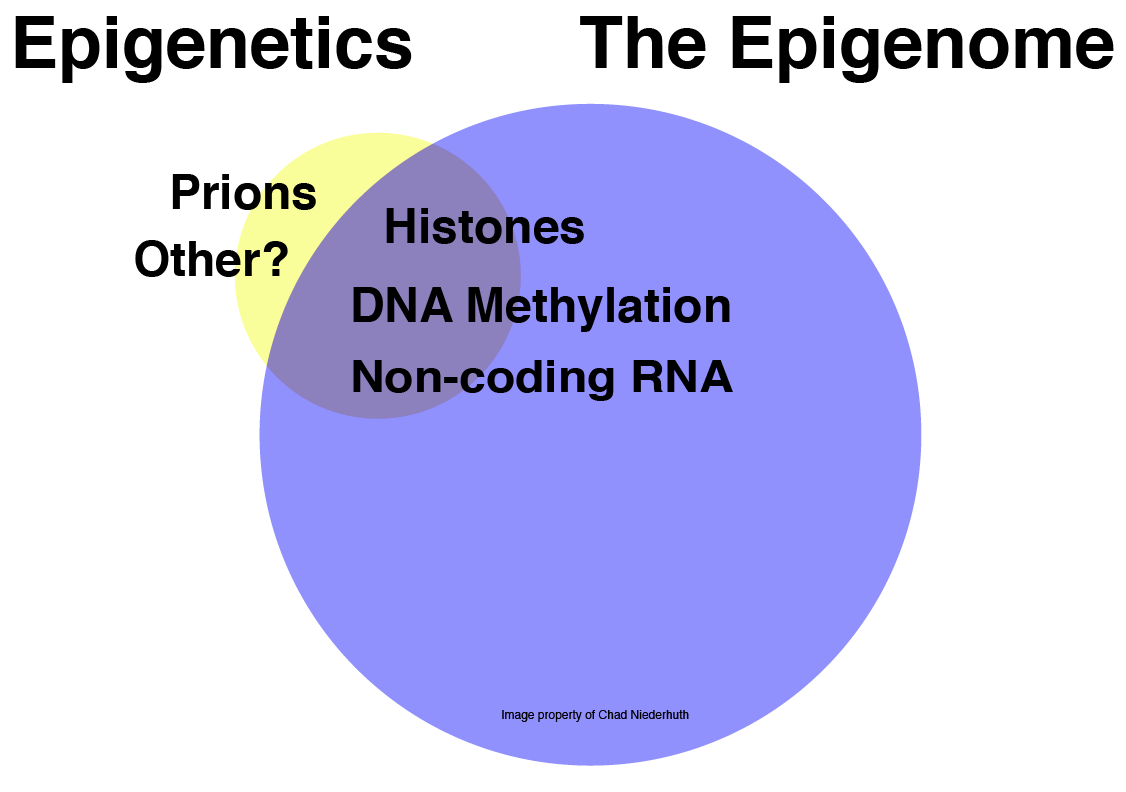BLOG
What is Epigenetics?
Epigenetics is confusing. It’s one of those scientific concepts, like quantum mechanics or “survival of the fittest”, that are often misunderstood and misapplied. How widespread this confusion is, is made evident by the publication of entire papers dedicated just to clarifying the term [1]. This is problematic not only scientifically, but also socially, as “epigenetics” is now even being used in marketing; typically to push the latest health scam. Hopefully this post can shed a little light on just what epigenetics is.
Epigenetics is the inheritance of a trait that is not due to differences in the DNA sequence.
There’s two key parts here. First, epigenetics is about inheritance of traits. So, if any two individuals differ in a trait, such as the shape of a flower or the color of a seed and those individuals then pass those differences onto their offspring, that’s inheritance. It’s not something that arises in an individual (or even a single cell) for a brief time and then disappears. Epigenetics requires that these differences be passed on across cell division and even across generations of an organisms.
Normally, and for most traits we understand, the inheritance of these differences in traits are due in part to differences in DNA sequence itself (genetics). This brings us to the second key part of that definition, the part which separates epigenetics from genetics: epigenetics is not due to differences in DNA sequence. This implies that there must be other mechanisms that gives rise to these trait differences. To show a trait is truly epigenetic then, requires careful testing to rule out genetic causes. It turns out this is very hard to do and we only know of a handful of examples of epigenetics.
Just as important as what is said in the definition, is what is left unsaid. The definition of epigenetics does not define a mechanism; it only excludes one. This means that any number of biological processes could underlie an epigenetic trait, if they are not due to genetic differences. These mechanisms can operate from the level of regulating DNA (without changing its sequence) on up to the level of protein folding (see “prions”).
An example of one such mechanism is DNA methylation. This is a modification made to specific bases in the DNA sequence, that do not actually change the sequence of the DNA itself. In some circumstances, DNA methylation is involved with turning genes on or off [2] and differences in the DNA methylation of specific genes between individuals may give rise to trait differences. These differences in DNA methylation can even sometimes be inherited [3,4]. In plants, some classic examples of this include flower shape in Toadflax [5] and fruit ripening in Tomato [6].
It’s important to note however, that just because some epigenetics sometimes involves mechanisms like DNA methylation, that not all DNA methylation is “epigenetic”. In fact, much of it is not and genetic differences underlie many of the differences in DNA methylation between individuals [7,8]. Not to make the issue any easier, scientists have confusingly referred to the study of mechanisms like DNA methylation in genomes as “epigenomics”. While there is an overlap between epigenetics and epigenomics, not all epigenetic phenomena involve epigenomic mechanisms or vice versus.
 Figure: Mechanistic relationship between Epigenetics and Epigenomics. Note that the area and overlap of the venn diagram is not based on any actual data, it’s just to illustrate a concept.
Figure: Mechanistic relationship between Epigenetics and Epigenomics. Note that the area and overlap of the venn diagram is not based on any actual data, it’s just to illustrate a concept.
Much of my lab’s work involves the study of epigenomic mechanisms, but this can be saved for another post. I should note that there continues to be discussion of what epigenetics is and is not within science and not everyone might agree with how I have defined it here. I’d really recommend reading the 1st reference of this post (Deans & Maggert) for a more in depth discission. I hope this has help clarified what epigenetics is and some of what epigenetics is not.
Written by Chad Niederhuth date: 2017-10-22T19:38:57-07:00
References
Deans, C., and K. A. Maggert, 2015 What do you mean, “epigenetic”? Genetics 199: 887-896.
Niederhuth, C. E., and R. J. Schmitz, 2017 Putting DNA methylation in context: from genomes to gene expression in plants. Biochim Biophys Acta 1860: 149-156.
Schmitz, R. J., M. D. Schultz, M. G. Lewsey, R. C. O’Malley, M. A. Urich et al., 2011 Transgenerational epigenetic instability is a source of novel methylation variants. Science 334: 369-373.
Becker, C., J. Hagmann, J. Muller, D. Koenig, O. Stegle et al., 2011 Spontaneous epigenetic variation in the Arabidopsis thaliana methylome. Nature 480: 245-249.
Cubas, P., C. Vincent and E. Coen, 1999 An epigenetic mutation responsible for natural variation in floral symmetry. Nature 401: 157-161.
Manning, K., M. Tor, M. Poole, Y. Hong, A. J. Thompson et al., 2006 A naturally occurring epigenetic mutation in a gene encoding an SBP-box transcription factor inhibits tomato fruit ripening. Nat Genet 38: 948-952.
Schmitz, R. J., M. D. Schultz, M. A. Urich, J. R. Nery, M. Pelizzola et al., 2013 Patterns of population epigenomic diversity. Nature 495: 193-198.
Kawakatsu, T., S. S. Huang, F. Jupe, E. Sasaki, R. J. Schmitz et al., 2016 Epigenomic Diversity in a Global Collection of Arabidopsis thaliana Accessions. Cell 166: 492-505.